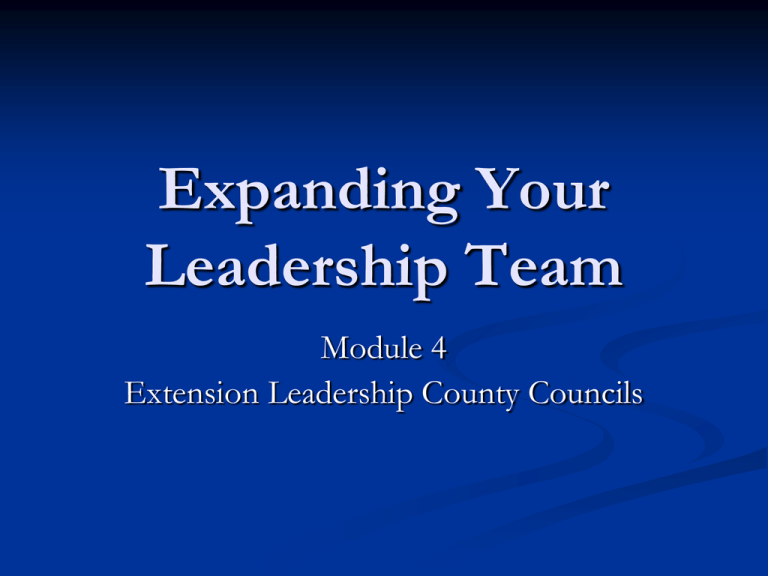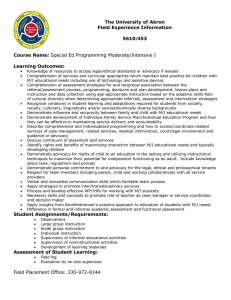Module 4
advertisement

Expanding Your Leadership Team Module 4 Extension Leadership County Councils What is the County Council? Purposes Primary The main mission of the Extension Leadership County Council is to cultivate and maintain overall ADVOCACY and SUPPORT for the total Extension program in your county Purposes Secondary Develop a marketing plan to show total county program impact to funding sources and public Facilitate marketing of educational events and use public events to demonstrate and communicate impact of Extension Purposes Secondary Facilitate communication and collaboration between Program Development Teams (PDTs), Extension program areas, and county staff Membership County Extension Agent(s) CEC CEA’s from each program area represented in county CEC & CEA’s serve as Ex-officio members 1-2 members of each Program Development Team (PDT) Membership One member representing each program area, at large Family Connection director, Cattleman's Assoc. president, BOE member, key volunteer, etc. Invited by CEC in consultation with CEA(s) 3-5 members from the community selected by the staff, led by CEC Past PDT members, BOE member, BOC member, special Extension supporters, etc. Meetings Minimum four per year (suggest quarterly) More meetings may be used as needed to keep group informed and focused 1st Meeting Educate/Orient Priority issues Educational programs Promote collaboration between PDTs and program areas to address issues Assist Council members in understanding the importance of each program area Meetings Another meeting option Plan and host an annual event that showcases the impact of Extension to funding sources and to the public Make sure elected officials, funding sources, special interest groups and general public can see the impact that all three programs areas have on county Consider consolidating duplicated efforts across program areas that have small impact into a larger issue driven impact Other Council meetings – Keep meetings focused on advocacy; not program development Advocacy By definition – advocacy is the active support for a cause, idea, or policy; also, it can be defined as arguing or pleading in favor of something Advocates for Extension should adhere to the message, “Cooperative Extension is …” Education Access Relevance Linkages Advocacy Advocates for Extension need: Knowledge Organization/Programs Clientele needs and benefits received Funding sources and needs Government process and structure Roles of elected officials Relationships/Network Communication Skills Advocacy vs. Lobbying Advocacy – strong support for a cause Lobbying – an attempt to influence decisionmaking, especially legislation Lobbying always includes advocacy; but advocacy does not always includes lobbying Cautions Don’t let purpose of County Council distract from, or draw focus away from, PDTs This group is to promote and support Extension and the program development PROCESS Many counties already have these: do not duplicate; this is an effort to streamline and encourage collaboration between program areas, reduce duplication and have greater impact Cautions Be careful that this group does not take on a life of its own. Keep them focused on the purpose(s) of the County Council Shared leadership is important, but giving up control of your programs or your office is not Can have tremendous impact on your county and county programming, even if you are doing similar activities now Will take a concentrated and collaborative effort from staff to make it successful DO’s and DON’T’s for County Councils DO: Encourage marketing of the entire Extension program, not individual events Train Council members to communicate the overall impact of Extension Select only Council members who have wide and extensive networks in the community Ensure that Council members are sharing the “Extension is …” message DO’s and DON’T’s for County Councils DON’T: Involve Council members in program development roles reserved for PDT Put people on the Council who are not willing to speak up and speak out – OFTEN! Meet less frequently than 4X per year (research shows this is ineffective) Allow Council members to advocate until they are fully educated and prepared Program Development Team 4-H Program Development ANR Program Development Coordinators Coordinators Norman McGlohon – NE District Al Parker – NE District Sheldon Hammond – NW District Ken Lewis – SW District Dr. Lori Purcell Bledsoe – NW District Phil Torrance – SE District Melinda Miller – SW District Kathy Baldwin – SE District FACS Program Development Specialists Janet Valente – NW & SW Districts Laurie Cantrell – NE & SE Districts Jeff Christie – Coordinator, Extension Leadership System
